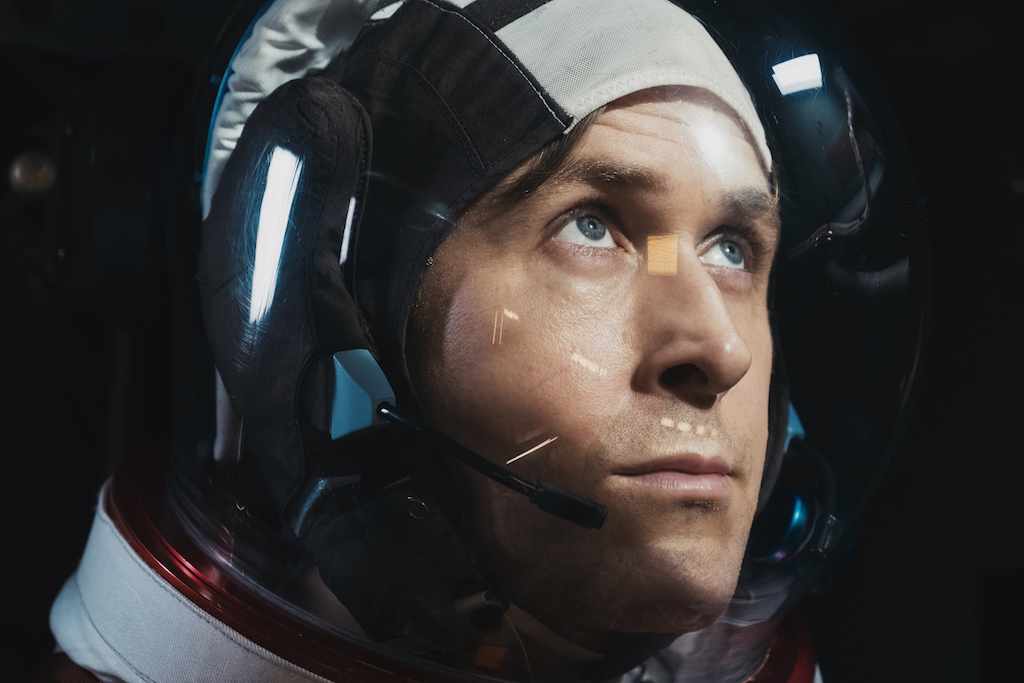
One of the first things you notice about First Man is how analog all the equipment is. The film starts with astronaut Neil Armstrong (Ryan Gosling) taking a test flight when something goes horribly wrong. The craft goes up when it should be going down, “bouncing off the atmosphere,” as the control room warns him. In his small, noisy cockpit, Armstrong shakes and rattles, he frantically fiddles with the kinds of knobs we associate with a switchboard or an old-timey radio. Finally, he’s able to land safely.
In scenes like this, and the many others that follow, director Damien Chazelle puts us inside the cramped, claustrophobic chambers that astronauts journeyed in and reminds us of the gonzo bravery of it all. These men were venturing blindly into the unknown, taking the ultimate leap of faith with far from perfected technology (at one point, a glitchy seatbelt is fixed with a Swiss Army Knife). Indeed, many didn’t survive.
Turns out, to be an astronaut in the late 60s meant dealing with a lot of death. Armstrong loses several of his fellow pilots to crashes and fires; it was an unspoken risk of the job.
But Armstrong, a reticent man by nature, was used to dealing with loss. His daughter, Karen, died of a brain tumor at the age of two and her death quietly haunts the entire film. Chazelle suggests that, despite his steely demeanor, Armstrong felt things quite deeply. We see him weeping for his dead daughter, once, alone in his office; beyond that he almost never mentions her—but in moments of distress, he flashes to memories of holding her in his arms and stroking her hair.
First Man is a technical triumph—a space film that focuses not on the vastness of the universe but the vulnerable humanness of the men who explored it. But despite Chazelle and Gosling’s best efforts, it does feel a bit cold at times. Even Neil’s wife, Janet Armstrong (Claire Foy), is depicted as a no-nonsense kind of woman—surprisingly, we never really see her grieve for Karen either. Instead, Janet is mostly the stock wife character, caring for the couples’ two rambunctious sons, holding down the fort at home, listening intently to the NASA feed when Neil is up in space, but never trying to dissuade him from going. I had been hoping that Janet could give us that emotional anchor the film sometimes lacks, but she’s almost as stoic as he is.
That being said, some people—particularly older men, I suspect—will be moved by the film’s clear hagiography of the Armstrongs, which interprets their repressed emotions as a kind of quiet dignity. There is a scene toward the end of the film specifically designed to make grown men cry. It will undoubtedly do the trick. (I confess, it also worked on me.)
First Man includes snippets of cultural context—Vietnam War protests, actual footage of Kurt Vonnegut disparaging the billions spent on space exploration, a recreation of Gil Scott Heron (Leon Bridges) singing “Whitey on the Moon”—but it feels perfunctory. Chazelle doesn’t actually grapple with those questions. He’s clearly awed by the astronauts and on their side. These snippets are his way of acknowledging: I guess not everyone finds this stuff as cool as I do.
Unsurprisingly, at two hours and 21 minutes, First Man feels a little indulgent. Still, it’s hard to deny the film’s accumulative power and stunning realism. In the same way that a great war film puts you on the battlefield, this film puts you inside the cockpit, inside the spacesuit, and inside those tremulous, heartstopping moments before Armstrong made his famous “leap for mankind.”
